Page 146 of 474
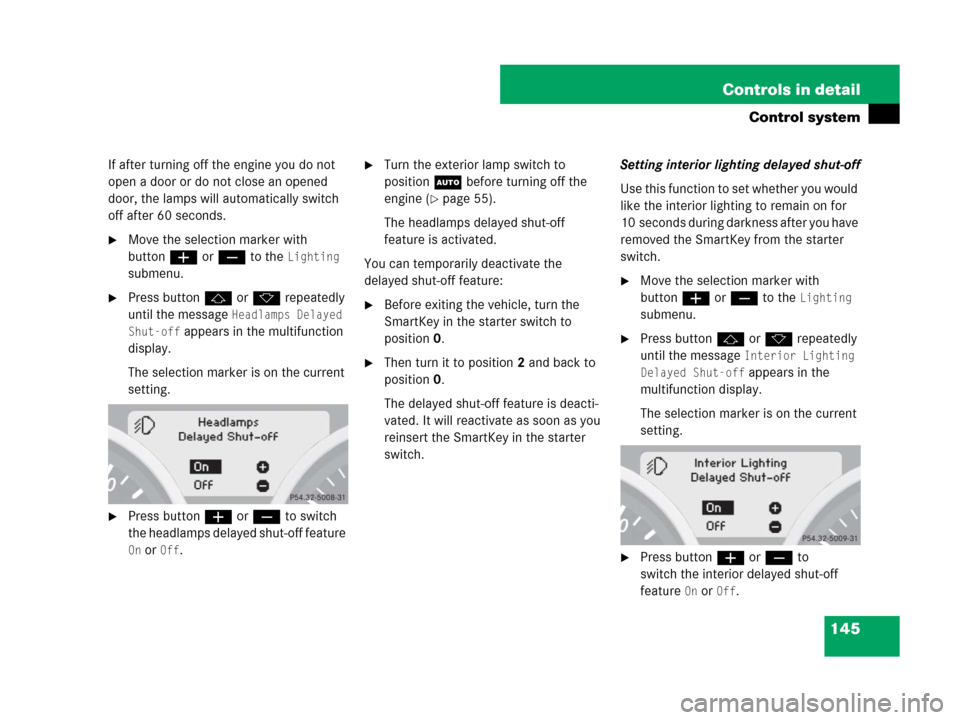
145 Controls in detail
Control system
If after turning off the engine you do not
open a door or do not close an opened
door, the lamps will automatically switch
off after 60 seconds.
�Move the selection marker with
buttonæorç to the
Lighting
submenu.
�Press buttonjork repeatedly
until the message
Headlamps Delayed
Shut-off
appears in the multifunction
display.
The selection marker is on the current
setting.
�Press buttonæorç to switch
the headlamps delayed shut-off feature
On or Off.
�Turn the exterior lamp switch to
positionU before turning off the
engine (
�page 55).
The headlamps delayed shut-off
feature is activated.
You can temporarily deactivate the
delayed shut-off feature:
�Before exiting the vehicle, turn the
SmartKey in the starter switch to
position0.
�Then turn it to position2 and back to
position0.
The delayed shut-off feature is deacti-
vated. It will reactivate as soon as you
reinsert the SmartKey in the starter
switch.Setting interior lighting delayed shut-off
Use this function to set whether you would
like the interior lighting to remain on for
10 seconds during darkness after you have
removed the SmartKey from the starter
switch.
�Move the selection marker with
buttonæorç to the
Lighting
submenu.
�Press buttonjork repeatedly
until the message
Interior Lighting
Delayed Shut-off
appears in the
multifunction display.
The selection marker is on the current
setting.
�Press buttonæorç to
switch the interior delayed shut-off
feature
On or Off.
Page 160 of 474
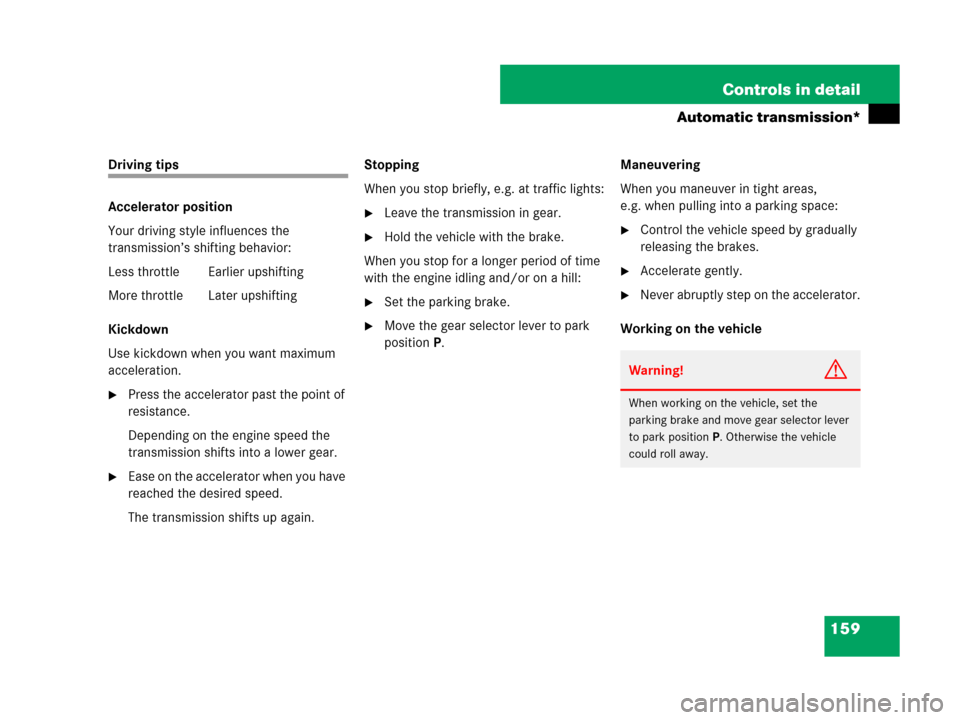
159 Controls in detail
Automatic transmission*
Driving tips
Accelerator position
Your driving style influences the
transmission’s shifting behavior:
Less throttle Earlier upshifting
More throttle Later upshifting
Kickdown
Use kickdown when you want maximum
acceleration.
�Press the accelerator past the point of
resistance.
Depending on the engine speed the
transmission shifts into a lower gear.
�Ease on the accelerator when you have
reached the desired speed.
The transmission shifts up again.Stopping
When you stop briefly, e.g. at traffic lights:
�Leave the transmission in gear.
�Hold the vehicle with the brake.
When you stop for a longer period of time
with the engine idling and/or on a hill:
�Set the parking brake.
�Move the gear selector lever to park
positionP.Maneuvering
When you maneuver in tight areas,
e.g. when pulling into a parking space:
�Control the vehicle speed by gradually
releasing the brakes.
�Accelerate gently.
�Never abruptly step on the accelerator.
Working on the vehicle
Warning!G
When working on the vehicle, set the
parking brake and move gear selector lever
to park positionP. Otherwise the vehicle
could roll away.
Page 169 of 474

168 Controls in detail
Good visibility
For information on the windshield wipers,
see “Windshield wipers” (
�page 56).
Headlamp cleaning system*
The headlamps will automatically be
cleaned with a high-pressure water jet
when you have
�switched on the headlamps
and
�operated the windshield wipers with
windshield washer fluid five times
When you switch off headlamps, the
counter resets.
For information on filling up the washer
reservoir, see “Windshield washer system
and headlamp cleaning system*”
(
�page 301).
Rear view mirrors
For more information on setting the rear
view mirrors, see “Mirrors” (
�page 46).
Interior rear view mirror, antiglare
position
�Tilt the mirror to the antiglare night
position by moving the lever towards
the windshield.
The interior rear view mirror is dimmed.Auto-dimming rear view mirrors*
The reflection brightness of the exterior
rear view mirrors and the interior rear view
mirror will respond automatically to glare
when
�ignition is switched on
and
�incoming light from headlamps falls on
the sensor in the interior rear view
mirror
The rear view mirrors will not react if
�reverse gearR is engaged
�interior lighting is switched on
Page 170 of 474
169 Controls in detail
Good visibility
Sun visors
The sun visors protect you from sun glare
while driving.
1Mirror lamp*
2Mounting
3Mirror cover
4Sun visor
Warning!G
The auto-dimming function does not react if
incoming light is not aimed directly at sen-
sors in the interior rear view mirror.
The interior rear view mirror and the exterior
rear view mirror on the driver’s side do not
react, for example, if the wind screen* is
installed.
Light hitting the mirror(s) at certain angles
(incident light) could blind you. As a result,
you may not be able to observe traffic
conditions and could cause an accident.
Warning!G
Exercise care when using the passen-
ger-side exterior rear view mirror. The mirror
surface is convex (outwardly curved surface
for a wider field of view). Objects in mirror
are closer than they appear. Check your
interior rear view mirror or glance over your
shoulder before changing lanes.
Page 171 of 474
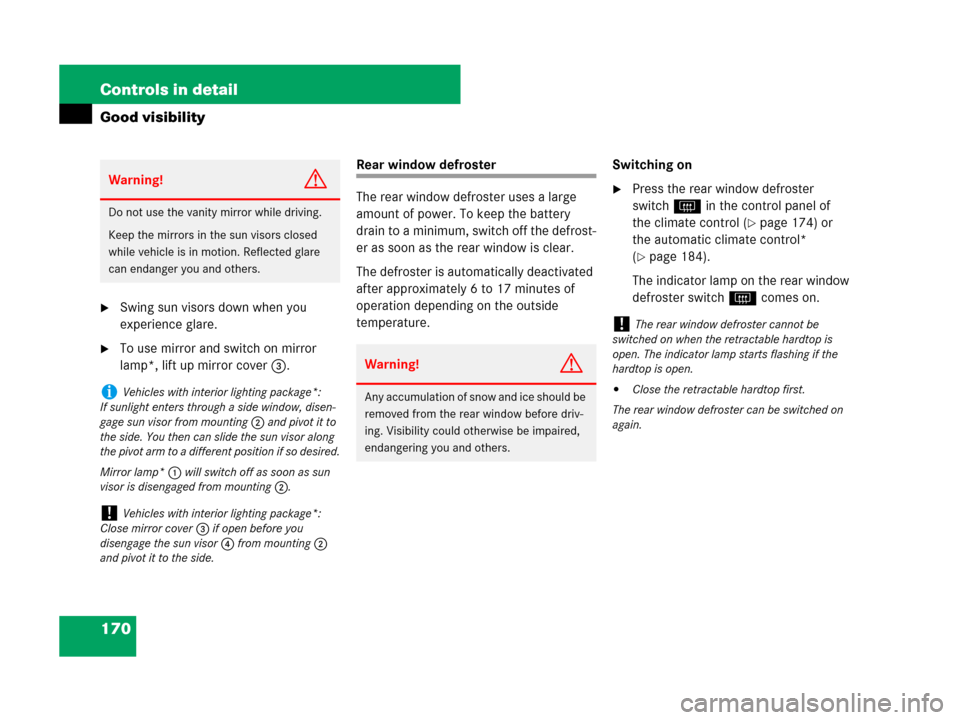
170 Controls in detail
Good visibility
�Swing sun visors down when you
experience glare.
�To use mirror and switch on mirror
lamp*, lift up mirror cover3.
Rear window defroster
The rear window defroster uses a large
amount of power. To keep the battery
drain to a minimum, switch off the defrost-
er as soon as the rear window is clear.
The defroster is automatically deactivated
after approximately 6 to 17 minutes of
operation depending on the outside
temperature.Switching on
�Press the rear window defroster
switchF in the control panel of
the climate control (
�page 174) or
the automatic climate control*
(
�page 184).
The indicator lamp on the rear window
defroster switchF comes on.
Warning!G
Do not use the vanity mirror while driving.
Keep the mirrors in the sun visors closed
while vehicle is in motion. Reflected glare
can endanger you and others.
iVehicles with interior lighting package*:
If sunlight enters through a side window, disen-
gage sun visor from mounting2 and pivot it to
the side. You then can slide the sun visor along
the pivot arm to a different position if so desired.
Mirror lamp*1 will switch off as soon as sun
visor is disengaged from mounting2.
!Vehicles with interior lighting package*:
Close mirror cover3 if open before you
disengage the sun visor4 from mounting2
and pivot it to the side.
Warning!G
Any accumulation of snow and ice should be
removed from the rear window before driv-
ing. Visibility could otherwise be impaired,
endangering you and others.
!The rear window defroster cannot be
switched on when the retractable hardtop is
open. The indicator lamp starts flashing if the
hardtop is open.
�Close the retractable hardtop first.
The rear window defroster can be switched on
again.
Page 176 of 474
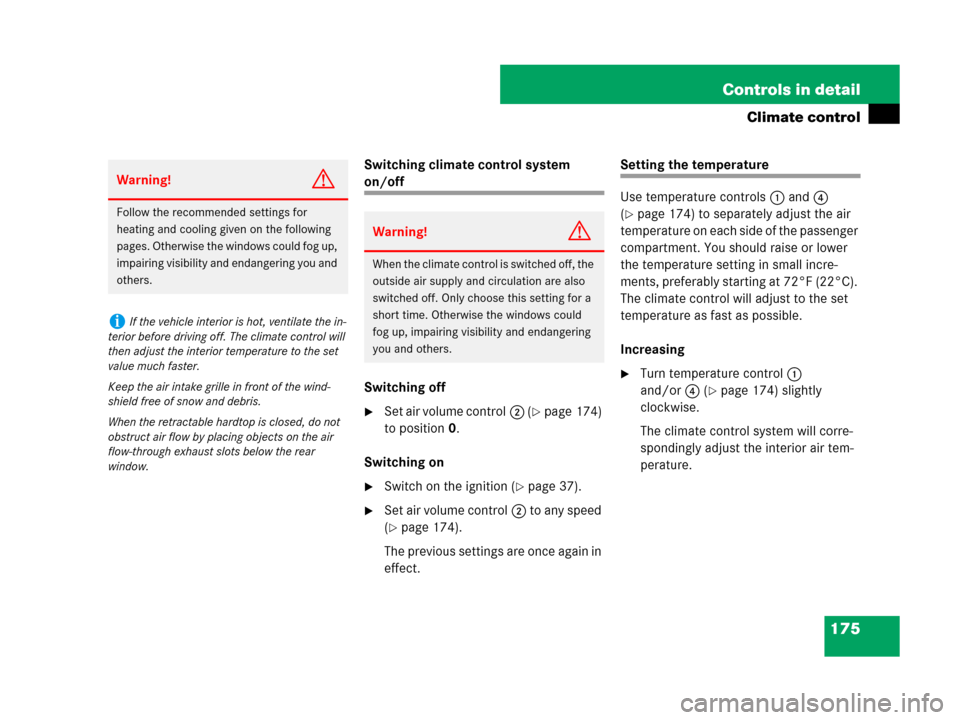
175 Controls in detail
Climate control
Switching climate control system
on/off
Switching off
�Set air volume control2 (�page 174)
to position0.
Switching on
�Switch on the ignition (�page 37).
�Set air volume control2 to any speed
(
�page 174).
The previous settings are once again in
effect.
Setting the temperature
Use temperature controls1 and4
(
�page 174) to separately adjust the air
temperature on each side of the passenger
compartment. You should raise or lower
the temperature setting in small incre-
ments, preferably starting at 72°F (22°C).
The climate control will adjust to the set
temperature as fast as possible.
Increasing
�Turn temperature control 1
and/or4 (
�page 174) slightly
clockwise.
The climate control system will corre-
spondingly adjust the interior air tem-
perature.
Warning!G
Follow the recommended settings for
heating and cooling given on the following
pages. Otherwise the windows could fog up,
impairing visibility and endangering you and
others.
iIf the vehicle interior is hot, ventilate the in-
terior before driving off. The climate control will
then adjust the interior temperature to the set
value much faster.
Keep the air intake grille in front of the wind-
shield free of snow and debris.
When the retractable hardtop is closed, do not
obstruct air flow by placing objects on the air
flow-through exhaust slots below the rear
window.
Warning!G
When the climate control is switched off, the
outside air supply and circulation are also
switched off. Only choose this setting for a
short time. Otherwise the windows could
fog up, impairing visibility and endangering
you and others.
Page 177 of 474
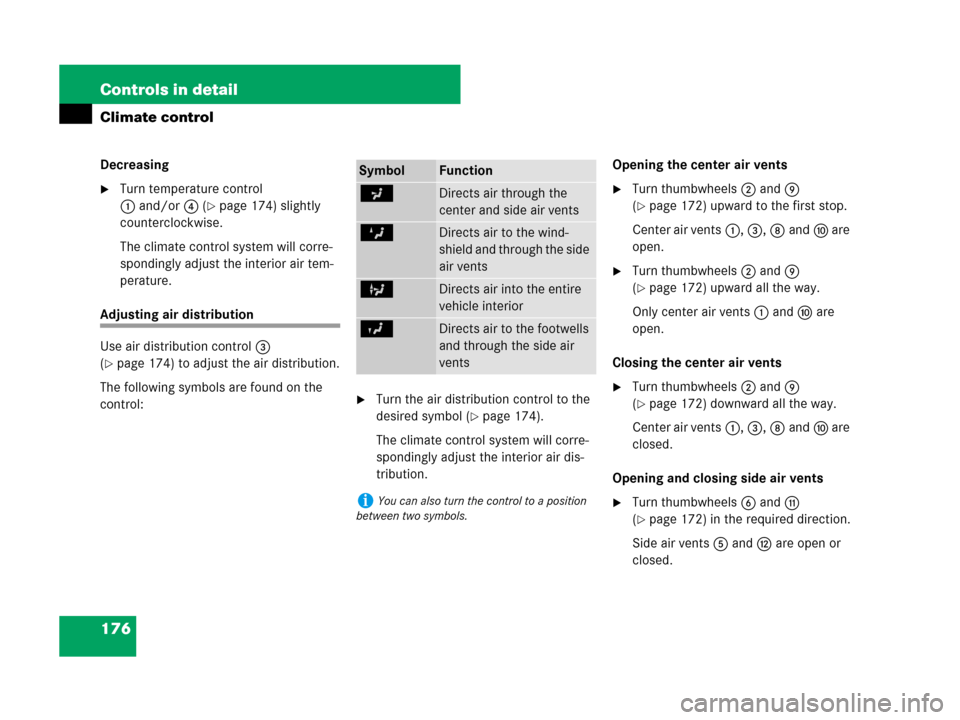
176 Controls in detail
Climate control
Decreasing
�Turn temperature control
1and/or4 (
�page 174) slightly
counterclockwise.
The climate control system will corre-
spondingly adjust the interior air tem-
perature.
Adjusting air distribution
Use air distribution control3
(
�page 174) to adjust the air distribution.
The following symbols are found on the
control:
�Turn the air distribution control to the
desired symbol (
�page 174).
The climate control system will corre-
spondingly adjust the interior air dis-
tribution.Opening the center air vents
�Turn thumbwheels2and9
(
�page 172) upward to the first stop.
Center air vents1,3,8anda are
open.
�Turn thumbwheels2and9
(
�page 172) upward all the way.
Only center air vents1anda are
open.
Closing the center air vents
�Turn thumbwheels2and9
(
�page 172) downward all the way.
Center air vents1,3,8anda are
closed.
Opening and closing side air vents
�Turn thumbwheels6andb
(
�page 172) in the required direction.
Side air vents5andc are open or
closed.
SymbolFunction
aDirects air through the
center and side air vents
ZDirects air to the wind-
shield and through the side
air vents
bDirects air into the entire
vehicle interior
YDirects air to the footwells
and through the side air
vents
iYou can also turn the control to a position
between two symbols.
Page 211 of 474
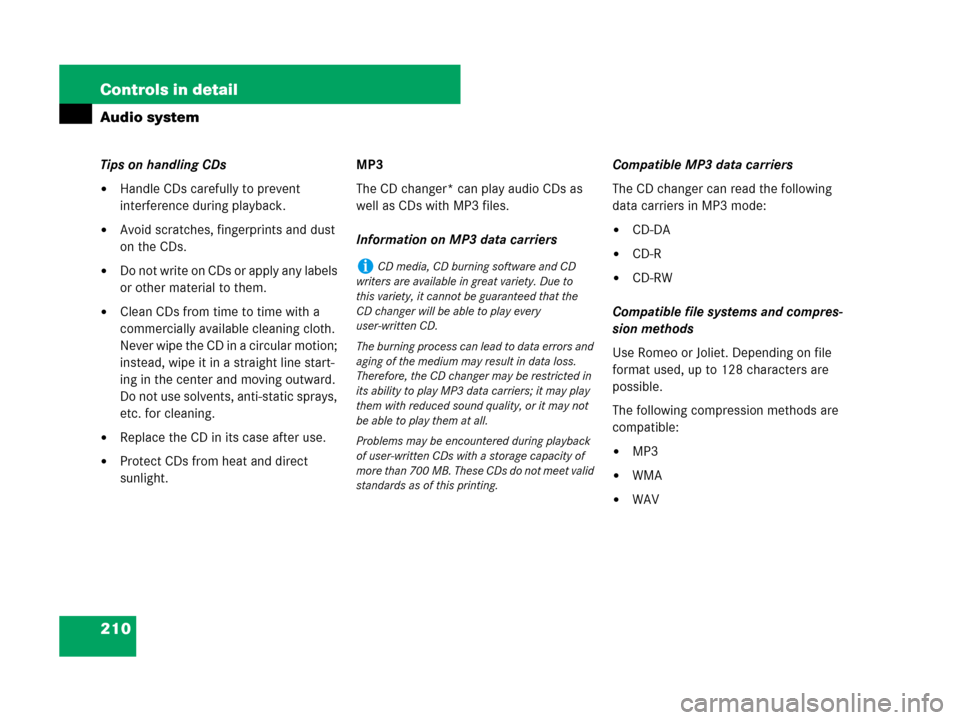
210 Controls in detail
Audio system
Tips on handling CDs
�Handle CDs carefully to prevent
interference during playback.
�Avoid scratches, fingerprints and dust
on the CDs.
�Do not write on CDs or apply any labels
or other material to them.
�Clean CDs from time to time with a
commercially available cleaning cloth.
Never wipe the CD in a circular motion;
instead, wipe it in a straight line start-
ing in the center and moving outward.
Do not use solvents, anti-static sprays,
etc. for cleaning.
�Replace the CD in its case after use.
�Protect CDs from heat and direct
sunlight.MP3
The CD changer* can play audio CDs as
well as CDs with MP3 files.
Information on MP3 data carriersCompatible MP3 data carriers
The CD changer can read the following
data carriers in MP3 mode:
�CD-DA
�CD-R
�CD-RW
Compatible file systems and compres-
sion methods
Use Romeo or Joliet. Depending on file
format used, up to 128 characters are
possible.
The following compression methods are
compatible:
�MP3
�WMA
�WAV
iCD media, CD burning software and CD
writers are available in great variety. Due to
this variety, it cannot be guaranteed that the
CD changer will be able to play every
user-written CD.
The burning process can lead to data errors and
aging of the medium may result in data loss.
Therefore, the CD changer may be restricted in
its ability to play MP3 data carriers; it may play
them with reduced sound quality, or it may not
be able to play them at all.
Problems may be encountered during playback
of user-written CDs with a storage capacity of
more than 700 MB. These CDs do not meet valid
standards as of this printing.